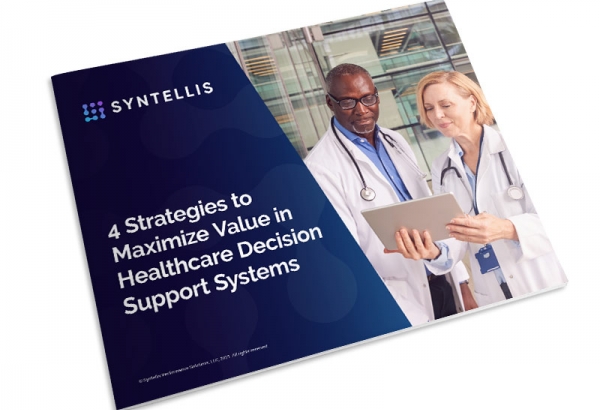Healthcare performance improvement and quality measures depend on access to high-quality data as well as a data governance function — adopting roles, processes, and tools to manage data and analytics. That’s why healthcare organizations that want to drive real, lasting change prioritize investments in data, analytics technology, and analysts who can generate meaningful insights from raw information.
The Healthcare Financial Management Association (HFMA) Finance Analytics Council, sponsored by Syntellis Performance Solutions since its inception in 2018, provides a forum for members to discuss and share best practices related to financial management topics. This blog series highlights council members’ suggestions around how to structure data governance functions.
Based on the council’s recent discussions, data governance and analytics in healthcare requires three components:
- Adopting a leadership structure and best practices for data and analysis (part 1)
- Collecting the right data and getting it into the hands of the right users (part 2)
- Measuring the return on data and analytics investment
As with any significant purchase, healthcare organizations must eventually demonstrate the value of that investment. This final post of the series explores how high-performing organizations prove return on investment (ROI) of data governance functions and tools.
Why Does ROI Matter?
In a recent HFMA Finance Council survey, nearly 67% of respondents said their biggest challenge in implementing data governance was executive attention and resources. While this can encompass resource limitations on the front end (e.g., the initial costs of tools and technology), it also reveals that healthcare organizations may not be effectively demonstrating the ROI of analytics.
“This points to a failure to connect analytics with process improvement, cost improvement, and variation improvement,” says Randy Albert, Vice President of Finance for Operations and Analytics at Northern Light Health. He explains that when organizations connect analytics to improvement measures and demonstrate a clear ROI, they aren’t as likely to run into resource constraints.
How Do Organizations Measure the Value of Their Data Investment?
Healthcare organizations’ approaches to data governance can vary widely; there is no one correct approach to measuring the value of that investment. Depending on the organization’s goals, there are several ways to demonstrate ROI.
Tie Financial Goals to Analytics
In hospitals and health systems, analytics teams often work in siloes, making it difficult to keep the organization aligned and accurately measure ROI.
That was the situation at Lakeland Regional Health – Florida, where Caroline Gay served as Senior Vice President and Chief Analytics Officer. Multiple analytics teams created confusion and resource strain. To provide clear direction and resource allocation, the organization formed one central analytics team with a clear-cut goal: “We had financial goals given to us that we needed to produce value of three times our team’s salary,” Gay explains. “So, we had a $3 million annual value proposition that we had to deliver on.”
Aligning analytics teams with specific financial and performance improvement goals provides precise direction for the teams and empowers them to generate a demonstrable ROI.
Assess Impact on Decision-Making
Finance teams in particular tend to think about ROI in terms of financial metrics such as number of patients and margin on those patients. However, healthcare organizations must also think beyond the numbers and consider if and how the organization relies on data and analytics to influence decision-making.
“The financial impact of our work comes by observing the results of the decisions that people make based on my team’s analytic input,” says Richard Pro, Chief Data and Analytics Officer at Cone Health. “If we engage with a small subset of departments across the organization and we impact only a small subset of their decisions, our value proposition to the organization is relatively small. But if we engage with most departments around the organization, and those people turn to us on a regular basis to ask for our assessment of information and recommendations to help them make decisions, then we have a big impact.”
Prioritize Analytics Projects Based on Value
An effective data governance function includes the ability to prioritize projects. Organizations can do that, in part, through quarterly governance council meetings to discuss current and upcoming needs. Additionally, high-performing organizations have developed more robust analytics hierarchy calculation methods to evaluate requests based on the value they will create.
Pro describes the process at his organization, which includes an intake form for analytics requests. “The questions on the form relate to value calculation,” he explains. “So, for example, does this request satisfy a regulatory requirement? Does it address a patient safety issue? Questions such as, ‘Is it expected to bring more than X dollars of net new revenue to the organization?' 'Is it expected to identify opportunities for cost savings greater than X dollars?’ add an assessment of financial return to the value equation.”
The form automatically generates a score to aid in the project prioritization process and demonstrate how each project adds value to the organization.
Moving from Descriptive to Prescriptive Analytics
Many healthcare organizations rely on descriptive analytics, which uses data to explore the reason why something happened or drove a past change. Though hospitals and health systems can apply that information to guess at future expectations, descriptive analytics really focus on reactive measures.
As organizations adopt more sophisticated data governance functions, they can enjoy the benefits of prescriptive analytics. Prescriptive analytics takes into account historical data and extrapolates meaningful information that can be applied proactively. “It asks ‘How could we do something differently to change the future outcome?’” explains Jay Spence, Vice President, Healthcare Software Solutions at Syntellis.
For example, a healthcare organization might review comparative benchmarks to determine how a department’s labor and non-labor expenses compare to similar internal and external departments. Armed with those analytics before embarking on the budgeting process, the organization can align its budget with those benchmarks — rather than reactively realize significant budget variances. With prescriptive analytics, healthcare organizations stand to make significant strides in patient care, quality outcomes, and operational performance.
AxiomTM Enterprise Decision Support empowers healthcare organizations to drive performance and decision-making with a single, trusted source of financial and clinical performance measures. Equipped with the right data, healthcare leaders can reduce costs, optimize revenue, and improve clinical quality.
Your peers also read...

How to Structure Data Governance in Healthcare

Measuring What Matters


